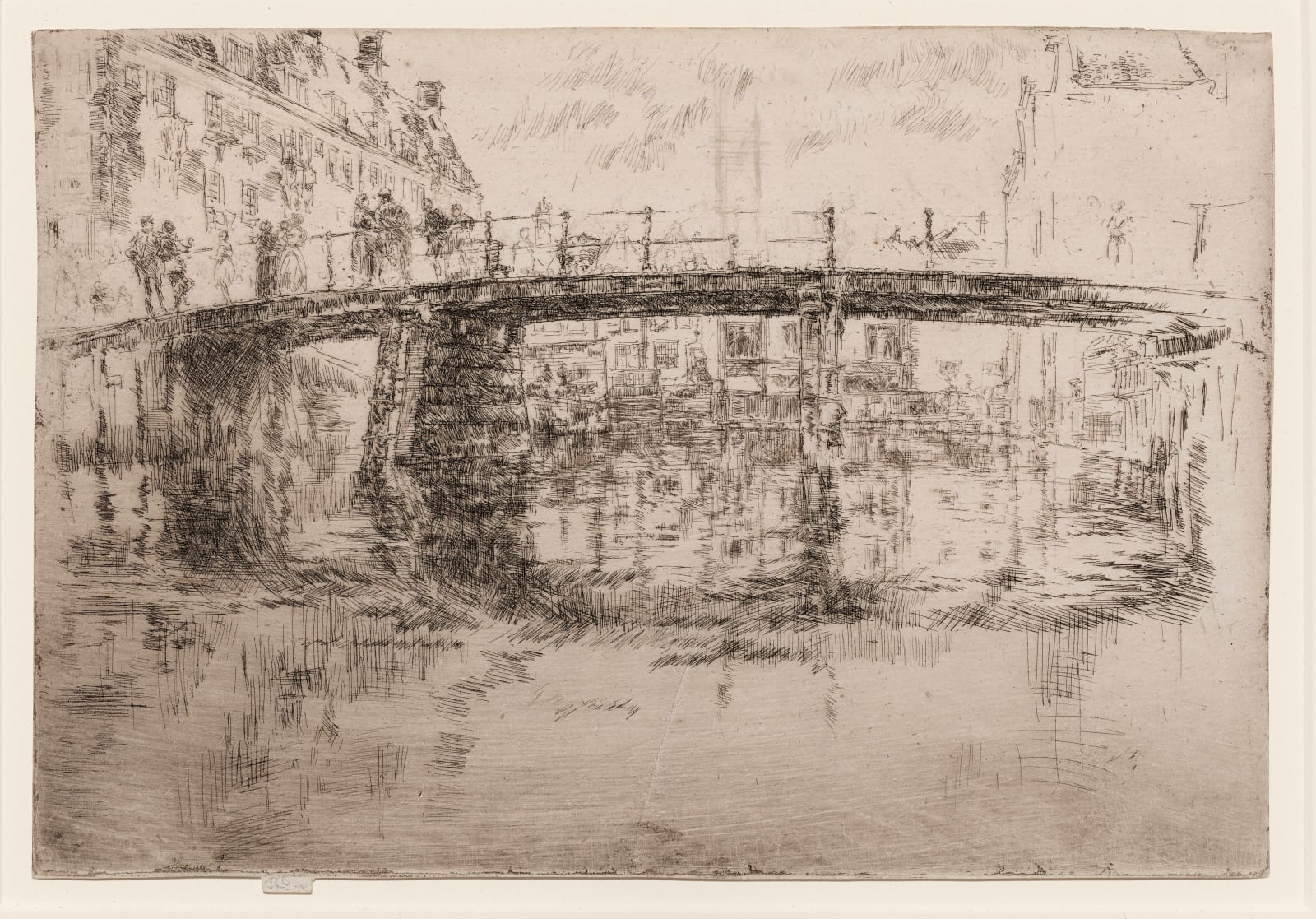James Abbott McNeill Whistler (1834-1903)
American’s Gilded Age artist James McNeill received international recognition early on in his career, participating in exhibitions of Les XX in Brussels and the Secession in Munich and Vienna. Whistler’s wish to visit Amsterdam, due to a lack of funds, was only fulfilled in 1863. His main goal was to visit the Rijksmuseum’s print room to study Rembrandt’s etchings and procure sheets of old Dutch paper.[1] After briefly attending a Rotterdam exhibition the following year, it would be almost two decades before his next trip to Holland.
Whistler turned wholeheartedly to etching again in 1887, producing nearly a hundred prints in England and Belgium. This highly productive year, with a total output of some 450 plates was a turning point, followed by thirty etchings made in Paris and beyond in 1888, culminating with the magnificent set of etchings done in Amsterdam in 1889. Elaborate, highly concentrated works, they show Whistler coming to terms with his medium and reveling in the possibilities of pure etching.
On 11 August 1888, Whistler married the artist Beatrice Godwin (1857-1896), the wealthy widow of E.W. Godwin, marking the happiest phase of Whistler’s life. Following the wedding, the Whistlers set off on a honeymoon to France, bringing thirty-four copper plates along.[2] Although Whistler had recently visited Holland in 1884, he was longing to return. On 24 August 1889, Whistler arrived in Amsterdam with the intention of making a series of ten copper plates.[3] Treading in the footsteps of Rembrandt, Whistler had some unpleasant encounters in his predecessor’s hometown. Working from a boat on one of the canals, women attempted to empty a bucket of water at him. Whistler called on the police who intercepted the women: “I looked up, dodging the filthy pails to see the women vanishing backward being carried off to wherever they carry people in Holland. After that, I had no more trouble, but I always had a policeman wherever I had a boat.”[4] In Amsterdam, Whistler must have been constantly reminded of Vermeer and Rembrandt via Japan. Both Bridge, Amsterdam and Little Drawbridge, Amsterdam recall the truncated views of slightly arched bridges found in Hiroshige and Hokusai, and reveal a poetic and ethereal aspect as the bridges traverse the shimmering surface of the canal. These etchings can be perceived as the grand finale of Whistler’s etching career. Beatrice wrote to Kennedy from Amsterdam that “Whistler though that “these plates will be among the finest he has done as they are very elaborate in character, and as they come from the country of the Knickerbockers they ought to be a great success in New York.”[5]
Thirteen lifetime impressions in all five states are known. In addition to the present first state, another impression is at the Freer Gallery in Washington, DC, while the location of a third impression of the first state is unknown. This impression has very little etched work in the water in the central part of the print, consistent with Whistler’s note on the verso that this is the first impression pulled. Whistler left waves of carefully wiped plate tone to represent the movement and shading of the water. In this early state the bridge railing in the center and shadow work in the buildings at the left are yet to be completed. In the later states Whistler also added heavy lines in the water and sky suggesting a storm.
In addition to the three first states, a second state is in the Cincinnati Art Museum, two third states are in the Art Institute of Chicago and in the Hamburger Kunsthalle, Hamburg, a fourth state is in the Freer Gallery as well, while fifth states are in the National Gallery of Art, Washington, DC., the Boston Public Library, MA, Colby College Museum of Art, ME, and Bibliothèque nationale de France, Paris. Of the three posthumous prints bequeathed to the University of Glasgow, one was gifted to the Rijksmuseum, Amsterdam, to enhance their collection of Dutch subjects. The cancelled copper plate is in the Hunterian, University of Glasgow.
[1] J.F. Heijbroek & Margaret F. MacDonald, Whistler and Holland, exh.cat. Rijksmuseum, Amsterdam 1997, pp. 49-53
[2] Lochnan, p. 243
[3] Lochnan p. 249. After a two-months visit, the Whistlers left the Netherlands on 20 October 1889
[4] Pennell, Life, II, 84
[5] Beatrice Whistler, letter to Kennedy, 29 September 1889, GUL BP 11 37/11Provenance
H. Wunderlich & Co., New York (stock no. A 33940)
George Washington Vanderbilt III (1914-1961), New York
The George W. Vanderbilt Collection of Etchings and Lithographs by James A. McNeill Whistler, Sotheby’s, New York, 15 May 1974, lot 282
P. & D. Colnaghi & Co., London
With Agnews, London, 1976
Harris Shrank Fine Prints, New York, by 2009
Exhibitions
London, Thos. Agnew & Sons Ltd., Whistler. The Graphic Work: Amsterdam, Liverpool, London, Venice, 6 – 30 July 1976;
Liverpool, Walker Art Gallery, 20 August – 26 September 1976;
Glasgow, Art Gallery and Museum, 7 October – 11 November 1976.



